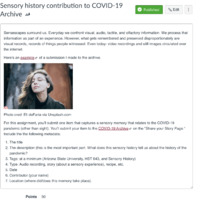Item
Patients without voices
Title (Dublin Core)
Patients without voices
Description (Dublin Core)
COVID-19 has changed many aspects of our lives, one that I would have never thought was using a mask in public. I began my Air Force career as a surgical technician in 1992. Wearing a mask was part of the job. The mask was worn to protect the patients, we did not want to breathe germs onto the surgical site. It had secondary a secondary purpose as well, to protect us from the patients' bodily fluids. Though talking was allowed in the surgical suite it was limited and the distance between the team was usually less than a few feet. We also learned to use hand gestures to communicate with each other, for instance if a surgeon was suturing and wanted us to cut the suture she or she would use the index and middle fingers to mimic scissors cutting. In 2008 found myself in Iraq, this time I had to shield my face not because I was in an operating room but because the sand storms. The mask allowed me to venture outside the facilities for limited periods of time during the storms. As medical professionals, depending on where you work, the use of masks is not something new. What is new is that now the patients are wearing masks. At first glance this might not seem like much of an issue, occasionally patients would have to wear masks as well. As most of us have noticed, communication has been hampered with the use of masks. It is harder to here, muffled voices, it is harder to differentiate between similar words/sounds, and we cannot use the use or other senses to assist us such as sight. In addition patients whom might have difficulty breathing have a harder times breathing by wearing masks.
It is imperative the communication between the patient and a clinician is flawless. If hearing is impaired or words are mistaken the consequences can be deadly. COVID-19 Has caused us to slow things down even further, we must double check and sometimes triple check to make sure we collected the correct information. We need to listen to what they are saying without the aid of their faces. Deaths caused by medical errors are a major concern for all, now add a barrier that is foreign to most patients and those errors can become even more common.
Now I find myself in Biloxi, MS and in some strange way everyone became an OR Tech, we are all wearing masks. On a serious note, may we all learn and grow from this experience and not let it go to waste.
It is imperative the communication between the patient and a clinician is flawless. If hearing is impaired or words are mistaken the consequences can be deadly. COVID-19 Has caused us to slow things down even further, we must double check and sometimes triple check to make sure we collected the correct information. We need to listen to what they are saying without the aid of their faces. Deaths caused by medical errors are a major concern for all, now add a barrier that is foreign to most patients and those errors can become even more common.
Now I find myself in Biloxi, MS and in some strange way everyone became an OR Tech, we are all wearing masks. On a serious note, may we all learn and grow from this experience and not let it go to waste.
Date (Dublin Core)
October 15, 2020
Creator (Dublin Core)
Tony Gurrola
Contributor (Dublin Core)
Tony Gurrola
Event Identifier (Dublin Core)
HST643
Partner (Dublin Core)
Arizona State University
Type (Dublin Core)
Photo
Controlled Vocabulary (Dublin Core)
English
Health & Wellness
English
Social Distance
English
Government Federal
Curator's Tags (Omeka Classic)
sensory history
mask
sound
muffled
Iraq
Air Force
Biloxi
Contributor's Tags (a true folksonomy) (Friend of a Friend)
sensory history
mask
Iraq
Air Force
patient
Collection (Dublin Core)
English
Military
English
Healthcare
Linked Data (Dublin Core)
Date Submitted (Dublin Core)
10/15/2020
Date Modified (Dublin Core)
10/16/2020
03/05/2021
This item was submitted on October 15, 2020 by Tony Gurrola using the form “Share Your Story” on the site “A Journal of the Plague Year”: http://covid-19archive.org/s/archive
Click here to view the collected data.

